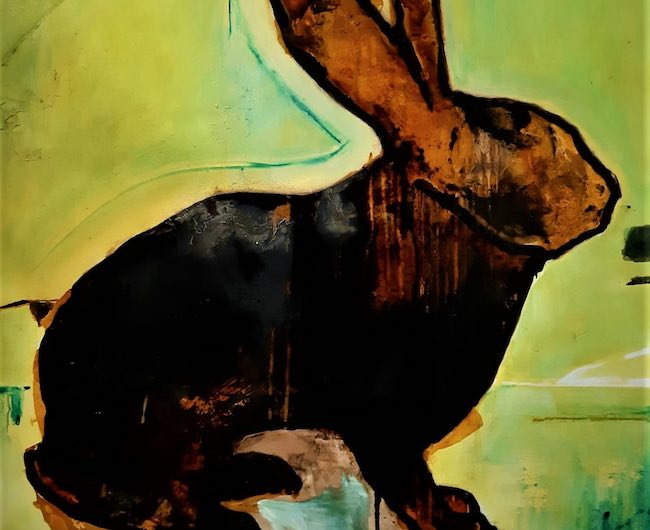Nell’immaginario collettivo la Pop Art rappresentava ai suoi esordi la leggerezza, il desiderio di parlare un linguaggio semplice e facilmente comprensibile dall’osservatore senza indurlo a porsi troppe domande, semplicemente fruendo di immagini familiari, perché appartenenti al mondo della televisione, del cinema, dei prodotti di largo consumo, dei fumetti. Al di là dell’apparenza iniziale si nascondeva però un significato più profondo poco spesso approfondito ma intuibile da un’analisi più attenta delle stesse opere. Nell’era contemporanea gli artisti hanno avuto, e hanno, l’opportunità di mescolare liberamente stili diversi e anche opposti a volte, per dare origine a inediti linguaggi pittorici che attingono al passato ma vengono attualizzati e adeguati all’individualità di ciascun creativo, il protagonista di oggi è uno tra questi.
Quando Andy Warhol decise di fondare un movimento artistico che andasse verso il grande pubblico, quello intimidito e lontano dal concettualismo di tutte le avanguardie della prima metà del Novecento le quali tendevano a staccarsi da ciò che lo sguardo conosceva per assumere un aspetto più intellettuale e al tempo stesso più epurato dall’estetica e dalla forma, tutto ciò che desiderava sottolineare era l’importanza di avvicinare le persone all’arte e il modo più funzionale e immediato era non solo citare visivamente, ridonando pertanto alla figurazione un ruolo primario, i nuovi miti e gli oggetti di uso quotidiano che grazie a lui potevano diventare protagonisti di un quadro, ma anche concependo la serigrafia come possibilità per la nuova classe borghese di potersi permettere di avere in casa un’opera d’arte che fosse economicamente accessibile. Il fenomeno della Pop Art esplose e riscosse un successo planetario e solo alcuni artisti vollero esprimere attraverso quelle opere colorate e divertenti lo spaccato di una società superficiale, legata al consumismo e orientata a inseguire l’effimero, la forma piuttosto che la sostanza; il medesimo movimento assunse connotazioni differenti da quelle del suo fondatore, come in James Rosenquist, che mescolava sapientemente le immagini patinate e ammalianti del mondo dello spettacolo e l’orrore della guerra spostando di fatto l’attenzione verso significati più profondi e sociali. In Europa, e soprattutto in Italia, la corrente diventò più intimista, più pungente nei confronti di una società che stava perdendo riferimenti solidi e si stava avviando verso una mancanza di punti di riferimento, verso l’assenza di memoria storica, di coscienza critica come nelle celeberrime tele di Mimmo Rotella, i cui manifesti recuperati rappresentano oggi uno sguardo su un’epoca apparentemente lontana eppure ancora vicina, oppure verso la storia recuperata e riadattata delle opere di Tano Festa, o ancora l’analisi critica nei confronti degli accadimenti internazionali e delle guerre di Franco Angeli. Forse è proprio a quest’ultimo che in qualche modo può essere riconducibile lo stile pittorico dell’artista romano Fabio Cicuto, più per l’approccio formale che non per quello sostanziale nel quale invece è presente in qualche modo un ritorno alle icone a volte fumettistiche altre legate ai simboli dell’immaginario collettivo; il suo passato da musicista ha contribuito a sviluppare una sensibilità e una capacità di riflessione nei confronti di un presente che spesso tende a correre troppo veloce impedendo di fatto alle persone, all’uomo contemporaneo, di cogliere quell’attimo fuggente spesso identificato come segreto per vivere una vita piena ma talmente momentaneo e transitorio da rendere impossibile riuscire a fermare l’istante e prendere atto degli eventi e meditare su se stesso.
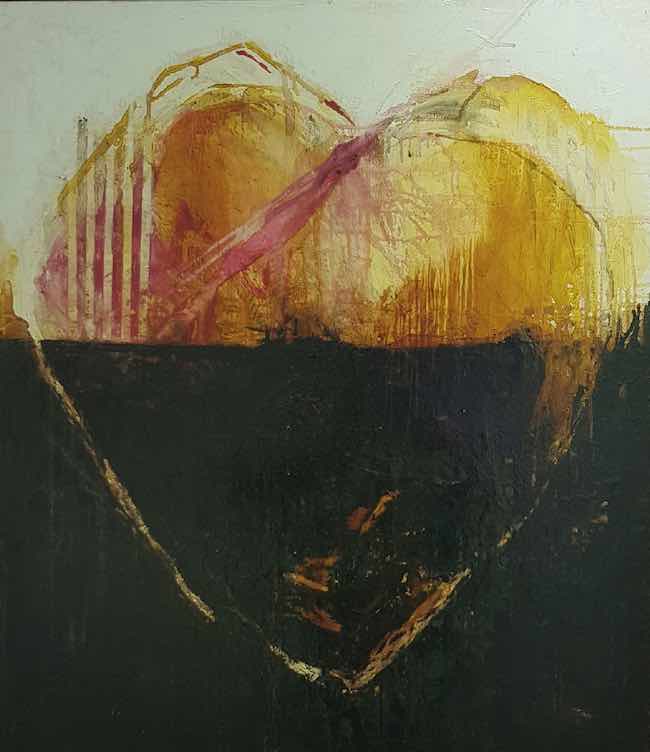
L’impatto visivo delle sue tele sembra essere sospeso tra il ricordo di un’immagine, di un qualcosa che è stato importante nel passato e che può raggiungere e persistere in quell’adesso che tra un istante sarà già passato, e l’andare verso il dopo portando con sé la consapevolezza della necessità degli eventi per indurre l’essere umano a riflettere su se stesso; ciò che si nasconde oltre la tela è un concetto filosofico, profondo tanto quanto la necessità di Cicuto di sperimentare, di trovare un canale comunicativo che riesca a raccontare il suo pensiero, il suo approccio nei confronti dell’esistenza e della realtà contemporanea, andando oltre il visibile e spostandosi verso il concetto che non può fare a meno di indurre l’osservatore a riflettere.
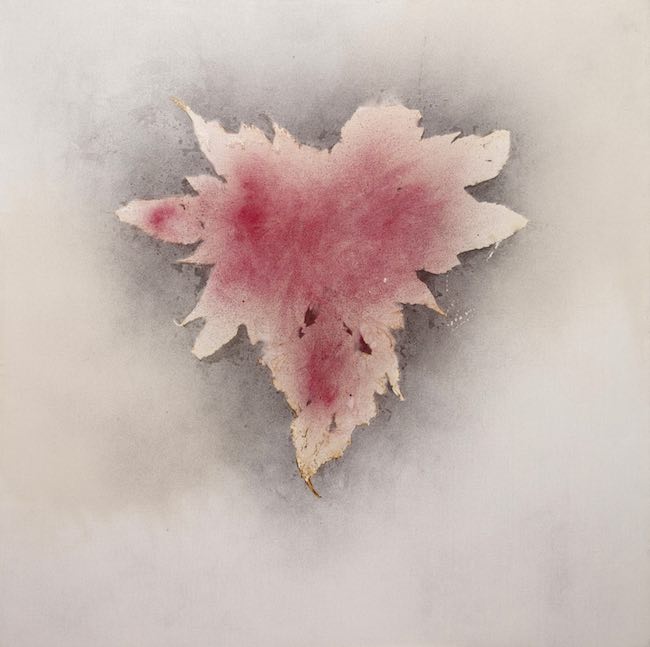
Le atmosfere delle tele sono nette nella parte figurativa tanto quanto gli sfondi sono irreali, sospesi tra il nulla e il tutto, come se la patina della quotidianità non potesse fare a meno di dissolversi davanti a simboli, ricordi, memorie in grado di tatuarsi letteralmente sull’anima e aprire un canale di dialogo interiore in cui l’approccio introspettivo e aperto nei confronti del mondo delle possibilità sia fondamentale per comprendere quel passato più o meno recente che ha lasciato strascichi, o quel presente da analizzare che non può non portare con sé anche tutti gli eventi, le circostanze, che lo hanno preceduto. Il conosci te stesso socratico diviene perciò la base essenziale dell’opera di Fabio Cicuto, una spinta all’approfondimento compiuta attraverso immagini iconiche, leggere solo a un primo sguardo ma subito dopo, leggendo il titolo che ha funzione interpretativa del dipinto stesso, in grado di condurre l’osservatore nel punto focale che l’artista desidera mettere in evidenza.

L’utilizzo del catrame rappresenta così una fase di stratificazione delle sensazioni, la necessità di sporcare la superficie per poi stimolare la consapevolezza compiendo una pulizia successiva in virtù dell’approccio empirico ma riconducente proprio all’applicazione nella vita quotidiana.

La tela Batman – Conversazione sull’identità attrae l’attenzione in virtù di un’immagine familiare, decisamente Pop, quella del supereroe più misterioso, ma poi vira un attimo dopo verso un senso più profondo che appartiene all’uomo contemporaneo che deve indossare una maschera perché spesso insicuro della propria reale personalità, convinto di non essere accettato per come è o impegnato a doversi proteggere dall’esterno. Questa tendenza, ampiamente analizzata nel Novecento da Luigi Pirandello, induce gli individui a non conoscersi reciprocamente, a non aprirsi all’altro celando pertanto la propria vera identità, o per meglio dire essenza, generando così interazioni e rapporti poco reali e per questo costantemente instabili.
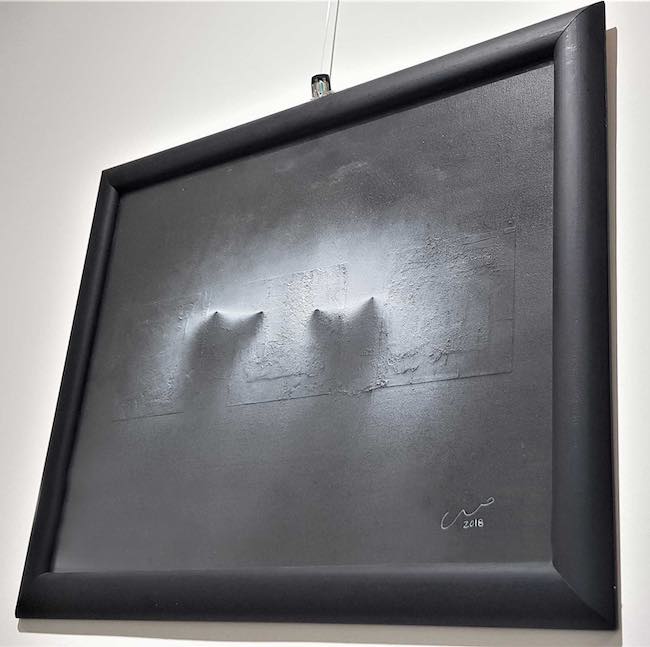
In Shadows of love pone l’attenzione proprio sulle complicazioni delle relazioni sentimentali, sull’entusiasmo che le contraddistingue in una fase iniziale e che poi va attenuandosi lasciando affiorare differenze, contrasti, incapacità di avere un dialogo aperto con l’altra parte, tutte concause di allontanamento, distanza malgrado la vicinanza fisica, e distacco fino al punto di lasciare alle spalle un’emozione inizialmente importante e apparentemente solida. L’obiettivo meditativo di Fabio Cicuto sottolinea quanto tutto assuma una rilevanza diversa una volta che l’individuo si allontana, si libera, dal senso di oppressione che appare non appena gli viene chiesto uno sforzo di comprensione, di più coinvolta interazione, di empatia, preferendo quasi distruggere piuttosto che conservare, fino al giorno in cui ciò che è stato chiuso si riapre sotto forma di ricordo, di nostalgia, di ombra che non può fare a meno di avvolgere il ricordo. Il Minimalismo di quest’opera, in cui l’artista utilizza la tecnica dell’estroflessione, la rende forse la più concettuale delle tele di Fabio Cicuto.
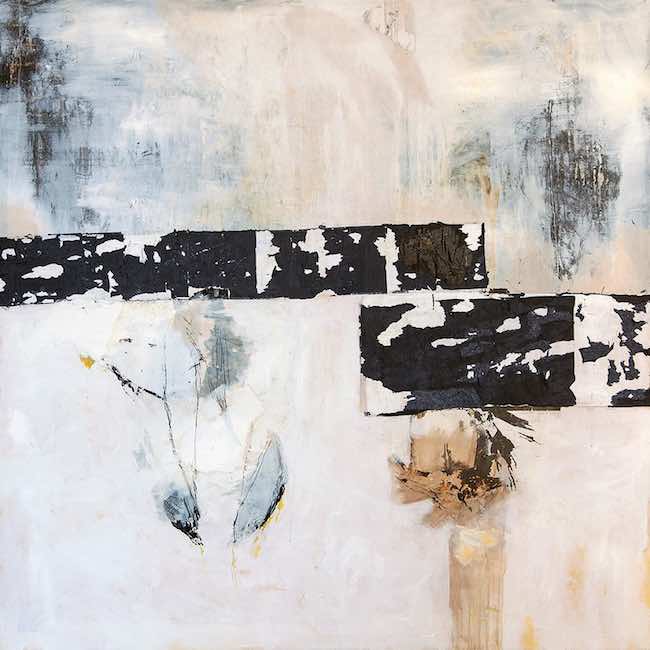
Tanto quanto le opere della serie Memories, anch’esse più informali, sembrano rappresentare il segno indelebile di tutto ciò che è stato, quei frammenti di vita e di esistenza che hanno tracciato una strada, raffigurata con una fascia frastagliata o a volte più netta, su cui l’individuo decide di basare i passi successivi, come se il trascorso fosse un monito.

Eppure l’artista sembra voler esortare l’osservatore a non permettere agli accadimenti di determinare il presente e di compromettere il futuro, e lo fa attraverso lo sfondo chiaro, sfumato, pieno di luminosità, come se quel passato che sembra costituire una cicatrice possa solo essere considerato un’esperienza, una parte necessaria del percorso di vita, ma non costituire un limite o la certezza che tutto ciò che è accaduto si ripeterà ancora. L’approccio di Fabio Cicuto è dunque riflessivo ma aperto al possibilismo che non può non contraddistinguere la vita stessa, sempre in bilico tra serietà e leggerezza, tra paure e capacità di sdrammatizzare, tra conoscenza di sé e disponibilità a lasciarsi andare al susseguirsi degli eventi. Fabio Cicuto ha alle spalle un percorso artistico di grande rilevanza, ha esposto in molti palazzi istituzionali di Roma, ha partecipato alla Biennale di Venezia, alcune sue opere fanno parte della collezione di Martin Stoecklin in Svizzera e ha partecipato nel 2021 alla Fiera d’Arte Moderna e Contemporanea di Roma Arte in Nuvola.
FABIO CICUTO-CONTATTI
Email: info@medinaroma.com
Sito web: www.fabiocicuto.it
Facebook: https://www.facebook.com/fabio.cicuto
https://www.facebook.com/medinaroma.arte
Instagram: https://www.instagram.com/cicutofabio/
Fabio Cicuto’s Conceptual Pop Art, between iconic symbols and introspective insight
In the collective imagination, Pop Art at its beginnings represented lightness, the desire to speak a simple language that was easily understood by the observer without inducing him to ask himself too many questions, simply by enjoying familiar images, because they belonged to the world of television, cinema, consumer products and comic strips. Beyond the initial appearance, however, a deeper meaning was concealed that was not often explored in depth but could be guessed from a more careful analysis of the artworks themselves. In the contemporary era, artists have had, and still have, the opportunity to freely mix different and even sometimes opposing styles to give rise to new pictorial languages that draw on the past but are brought up to date and adapted to the individuality of each creative, today’s protagonist is one of them.
When Andy Warhol decided to found an artistic movement that would reach out to the general public, one that was intimidated by and far removed from the conceptualism of all the avant-gardes of the first half of the 20th century, which tended to detach themselves from what the eye knew and take on a more intellectual aspect that was at the same time more purged of aesthetics and form, all he wished to emphasise was the importance of bringing people closer to art, and the most functional and immediate way was not only to visually cite, thus restoring a primary role to figuration, the new myths and everyday objects that thanks to him could become protagonists in a painting, but also to conceive of silk-screen printing as a possibility for the new middle class to be able to be able to have an affordable work of art in their homes. The Pop Art phenomenon exploded and enjoyed worldwide success, and only a few artists wanted to express through those colourful and amusing artworks the cross-section of a superficial society, tied to consumerism and oriented towards pursuing the ephemeral, the form rather than the substance; the same movement took on different connotations from those of its founder, as in James Rosenquist, who skilfully mixed the glossy and bewitching images of the world of show business and the horror of war, shifting the focus towards deeper and more social meanings.
In Europe, and above all in Italy, the current became more intimist, more pungent towards a society that was losing solid references and was heading towards a lack of reference points, towards the absence of historical memory, of critical conscience as in the famous canvases of Mimmo Rotella, whose recovered posters today represent a glimpse of an era that is apparently far away and yet still close, or towards the recovered and readapted history of the paintings of Tano Festa, or even the critical analysis of international events and wars by Franco Angeli. Perhaps it is precisely to the latter that the painting style of the Roman artist Fabio Cicuto can in some way be traced, more for the formal approach than for the substantive one in which instead there is in some way a return to icons, sometimes comic-stripes, others linked to the symbols of the collective imagination; his past as a musician has contributed to develop a sensitivity and capacity for reflection on a present that often tends to run too fast, preventing people, contemporary man, from grasping that fleeting moment often identified as the secret to live a full life, but so momentary and transitory that it is impossible to stop the instant and take note of events and meditate on himself. The visual impact of his canvases seems to be suspended between the memory of an image, of something that was important in the past and that can reach and persist in the now that in a moment’s time will have already passed, and the moving towards the later bringing with it an awareness of the necessity of events to induce human beings to reflect on themselves; what lies beyond the canvas is a philosophical concept, as profound as Cicuto’s need to experiment, to find a communicative channel that succeeds in narrating his thought, his approach to existence and contemporary reality, going beyond the visible and moving towards the concept that cannot help but induce the observer to reflect.
The atmospheres of the canvases are as clear in the figurative part as the backgrounds are unreal, suspended between nothingness and everything, as if the patina of everyday life could not help but dissolve in front of symbols, memories, reminiscences capable of literally tattooing themselves on the soul and opening up a channel of inner dialogue in which an introspective and open approach to the world of possibilities is fundamental to understand that more or less recent past that has left its mark, or that present to be analysed that cannot fail to also bring with it all the events, the circumstances, that have preceded it. The Socratic ‘know thyself’ therefore becomes the essential basis of Fabio Cicuto’s work, a push for in-depth study accomplished through iconic images, light only at first glance but immediately afterwards, reading the title that has an interpretative function of the painting itself, capable of leading the observer to the focal point that the artist wishes to highlight. The use of tar thus represents a layering phase of sensations, the need to dirty the surface in order to then stimulate awareness by subsequent cleaning by virtue of the empirical approach but leading right back to application in everyday life. The canvas Batman – Conversation on identity attracts attention by virtue of a familiar, decidedly Pop image, that of the most mysterious superhero, but then veers a moment later towards a deeper sense that belongs to the contemporary man who must wear a mask because he is often unsure of his real personality, convinced that he is not accepted for who he is or committed to have to protect himself from the outside world.
This tendency, widely analysed in the 20th century by Luigi Pirandello, induces individuals not to know each other, not to open up to each other, thus concealing their true identity, or rather essence, thus generating interactions and relationships that are not very real and for this reason constantly unstable. In Shadow of love focuses precisely on the complications of sentimental relationships, on the enthusiasm that characterises them in an initial phase and which then fades away, leaving differences, contrasts and the inability to have an open dialogue with the other party to surface, all concomitant causes of estrangement, distance despite physical proximity, and detachment to the point of leaving behind an initially important and apparently solid emotion. Fabio Cicuto’s meditative lens emphasises how everything takes on a different significance once the individual moves away, frees himself, from the sense of oppression that appears as soon as he is asked for an effort of understanding, of more involved interaction, of empathy, preferring almost to destroy rather than preserve, until the day when what has been closed off reopens in the form of memory, of nostalgia, of shadow that cannot help but envelop the memory. The Minimalism of this artwork, in which the artist uses the technique of extroversion, makes it perhaps the most conceptual of Fabio Cicuto’s canvases.
As much as the paintings of the series Memories, which are also more informal, seem to represent the indelible sign of all that has been, those fragments of life and existence that have traced a path, depicted with a jagged or sometimes sharper band, on which the individual decides to base his next steps, as if the past were a warning. And yet the artist seems to want to exhort the observer not to allow events to determine the present and compromise the future, and he does this through the light, shaded background, full of luminosity, as if that past that seems to constitute a scar can only be considered an experience, a necessary part of the path of life, but not constitute a limit or certainty that everything that has happened will happen again. Fabio Cicuto’s approach is therefore reflective but open to the possibilism that cannot but characterise life itself, always poised between seriousness and lightness, between fears and the ability to play it down, between self-knowledge and the willingness to let oneself go to the succession of events. Fabio Cicuto has a very important artistic career behind him, he has exhibited in many institutional buildings in Rome, participated in the Venice Biennale, some of his artworks are part of Martin Stoecklin’s collection in Switzerland, and he participated in the 2021 Rome Modern and Contemporary Art Fair Arte in Nuvola.


